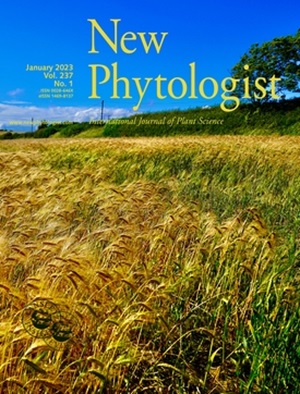Assembly mechanism of the β-carboxysome shell mediated by the chaperone CcmS
IF 8.3
1区 生物学
Q1 PLANT SCIENCES
引用次数: 0
Abstract
- Carboxysomes are self-assembled bacterial microcompartments (BMCs) that encapsulate the enzymes RuBisCO and carbonic anhydrase into a proteinaceous shell, enhancing the efficiency of photosynthetic carbon fixation. The chaperone CcmS was reported to participate in the assembly of β-carboxysomes; however, the underlying molecular mechanism remains elusive.
- We report the crystal structure of CcmS from Synechocystis sp. PCC 6803, revealing a monomer of α/β fold. Moreover, its complex structures with two types of BMC hexamers, CcmK1 homohexamer and CcmK1-CcmK2 heterohexamer, reveal a same pattern of CcmS binding to the featured C-terminal segment of CcmK1.
- Upon binding to CcmS, this C-terminal segment of CcmK1 is folded into an amphipathic α-helix protruding outward that might function as a hinge to crosslink adjacent BMC-H hexamers, thereby facilitating concerted and precise assembly of the β-carboxysome shell. Deletion of the ccmS gene or the 8-residue C-terminal coding region of ccmK1 resulted in the formation of aberrant and fewer carboxysomes, suppressed photosynthetic capacity in Synechocystis sp. PCC 6803.
- These findings enable us to propose a putative model for the chaperone-assisted assembly of β-carboxysome shell and provide clues for the design and engineering of efficient carbon fixation machinery.
伴侣蛋白CcmS介导β-羧基体壳的组装机制
羧小体是自组装的细菌微室(BMCs),它将酶RuBisCO和碳酸酐酶包裹在一个蛋白质壳中,提高光合作用固碳的效率。据报道,伴侣CcmS参与β-羧基体的组装;然而,潜在的分子机制仍然难以捉摸。我们报道了Synechocystis sp. PCC 6803 CcmS的晶体结构,显示一个α/β折叠单体。此外,它与两种类型的BMC六聚体CcmK1同质六聚体和CcmK1- ccmk2异质六聚体的复杂结构揭示了CcmS与CcmK1特征c端片段结合的相同模式。在与CcmS结合后,CcmK1的c端片段被折叠成一个向外突出的两亲α-螺旋,可能作为铰链连接相邻的BMC-H六聚体,从而促进β-羧基体外壳的协调和精确组装。ccmS基因或ccmK1的8个残基c端编码区缺失,会导致Synechocystis sp. PCC 6803的羧基体数量减少,从而抑制光合能力。这些发现使我们能够提出一种伴侣辅助β-羧基体壳组装的假设模型,并为高效固碳机械的设计和工程提供线索。
本文章由计算机程序翻译,如有差异,请以英文原文为准。
求助全文
约1分钟内获得全文
求助全文
来源期刊

New Phytologist
生物-植物科学
自引率
5.30%
发文量
728
期刊介绍:
New Phytologist is an international electronic journal published 24 times a year. It is owned by the New Phytologist Foundation, a non-profit-making charitable organization dedicated to promoting plant science. The journal publishes excellent, novel, rigorous, and timely research and scholarship in plant science and its applications. The articles cover topics in five sections: Physiology & Development, Environment, Interaction, Evolution, and Transformative Plant Biotechnology. These sections encompass intracellular processes, global environmental change, and encourage cross-disciplinary approaches. The journal recognizes the use of techniques from molecular and cell biology, functional genomics, modeling, and system-based approaches in plant science. Abstracting and Indexing Information for New Phytologist includes Academic Search, AgBiotech News & Information, Agroforestry Abstracts, Biochemistry & Biophysics Citation Index, Botanical Pesticides, CAB Abstracts®, Environment Index, Global Health, and Plant Breeding Abstracts, and others.
 求助内容:
求助内容: 应助结果提醒方式:
应助结果提醒方式:


